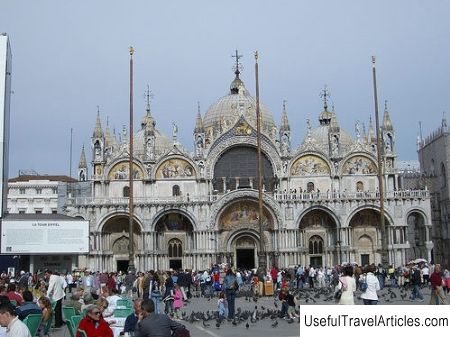Cathedral of St. Mark (Basilica San Marco) description and photos - Italy: Venice
Rating: 7,9/10 (2212 votes) 
St. Mark's Cathedral (Basilica San Marco) description and photos - Italy: Venice. Detailed information about the attraction. Description, photographs and a map showing the nearest significant objects. The title in English is Basilica San Marco. Photo and descriptionThis monument combines the political, social and religious history of the Venetian Republic. The cathedral was built in 829 during the reign of Doge Giustiano Partechipazio to store the remains of the Evangelist Saint Mark, who became the sole patron of the city. After the fire of 927, the basilica was rebuilt in 1043-1071 by the Doge Domenico Contarini. The lower part of the facade, 51.8 meters long, slightly pushed forward, consists of five arched spans, with columns decorated with eastern capitals ... The middle arch is wider than the others. The semicircles of the portal arches are covered with mosaics. Between the arches there are beautiful 12th century Byzantine bas-reliefs depicting the Virgin Mary, St. George, St. Dimitri, and others. The entire lower part is covered with a terrace surrounded by a balustrade. In the upper part there are five arches covered with mosaics, decorated with fantastic Gothic spiers. The central arch is wider than other arches and is glazed, through which light enters the cathedral. The crowning element of the facade reveals five round vaults in the oriental style of the 13th century. On the terrace, in front of the glazed central archway, four famous bronze horses are installed, which at one time were gilded. This is a Greek masterpiece of the 4th-3rd centuries BC, which is attributed to Lysippos. These horses were brought to Venice from Constantinople by the Doge Enrico Dandolo in 1204 and were installed on the terrace in 1250. Recently, they have been restored to preserve the integrity of the bronze. The originals, currently in the Cathedral Museum, have been replaced by copies. From the central portal you can get to the atrium - a beautiful gallery of colored mosaics. It is divided into arched spans with a dome. The walls have marble columns of various origins, some may have been brought from the Temple of Solomon in Jerusalem. The mosaics decorating arches, semicircles and domes depict episodes of the Old and New Testaments, as well as episodes from the history of Noah and the Flood. They were made by Venetian masters of the 13th century. The three-nave interior of the cathedral is divided by arched spans on marble columns with gilded capitals. According to the Eastern custom, the choir was separated from the temple by an iconostasis decorated with polychrome marble, in eight columns supporting an architrave on which statues of the Virgin Mary and the Apostles are installed. The marble floor is tiled in some places and is uneven due to subsidence of the ground, into which piles are driven and on which the cathedral rises. In one of the chapels is kept Madonna Nicopeia (Victorious), a Byzantine icon of the 10th century, which was brought to Venice after the fourth crusade in 1204. The main altar of the cathedral keeps the remains of Mark the Evangelist in an urn behind bars. Above the main altar there is a real medieval jewelery masterpiece - Pala dOro (The Golden Image). In 978, Doge Pietro Orseolo commissioned this altar to the masters of Constantinople. In 1105, it was redesigned by order of the Doge Ordelafo Faliero, and in 1209 it was additionally enriched with Byzantine gold and enamel. The piece is 3.4 meters long and 1.4 meters wide, richly decorated with diamonds, emeralds, rubies, topazes. In the center of the Baptistery there is a baptismal font, executed by Titian Minio, Desiderio da Firenze and Francesco Segal in the 15th century after a drawing by Jacopo Sansovino. Segal also owns the statue of St. John the Baptist. Here, among the graves of famous doges, there is also the grave of Jacopo Sansovino. The Phoenician granite slab on which the altar stands is possibly the slab from which Christ preached. The mosaic covering the walls, vaults and domes was made by Venetian craftsmen in the 14th century and depicts episodes from the life of the Baptist and Jesus Christ.         We also recommend reading Assumption Cathedral and the belfry of the Rostov Kremlin description and photos - Russia - Golden Ring: Rostov the Great Topic: Cathedral of St. Mark (Basilica San Marco) description and photos - Italy: Venice. |




